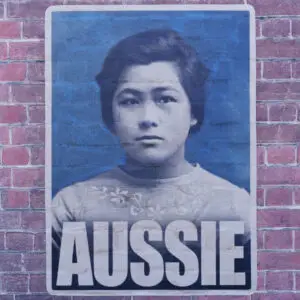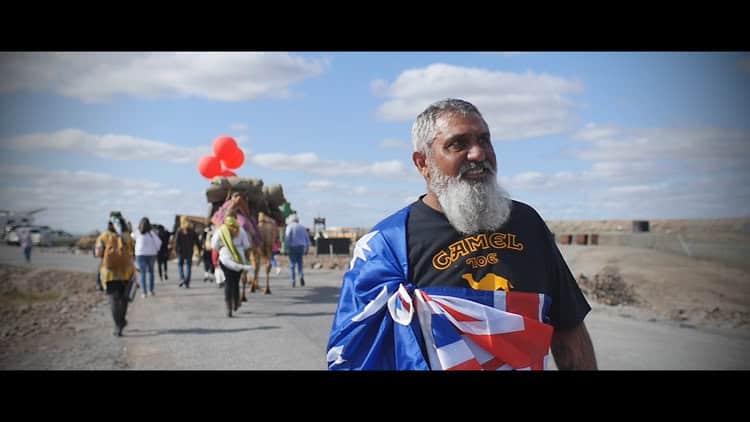The idea of ‘Aussie’: refugees, images & citizenship
Australian Academy of the Humanities 2024-06-20

First appearing in 2016, artist Peter Drew‘s ‘Aussie’ posters have become a familiar part of Australia’s urban streetscape. They offer a simple, striking visual formula, showing photographs of non-white people stamped across the bottom with the large word ‘AUSSIE’ – affectionate slang for ‘Australian’.
The subjects were born or lived in Australia during the early twentieth century and evaded the exclusionary provisions of immigration law under the White Australia Policy, being granted the right to leave Australia and return. The photographs provided proof of identity and are now held by the National Archives of Australia. Blown up to larger-than-life proportions, these poster portraits assume a dignity and gravitas that magnifies the impact of the palm-sized original.
As a form of public wallpaper, the flimsy brown sheets become ripped and scarred — a surface wear and tear which is part of their attraction: like graffiti or a mural they are a democratic, public statement. Drew’s aim in this work was to interrogate the category ‘Australian’ and ‘pose a question about the casual assumptions that underlie Australia’s identity’.
Visual culture & asylum seeker policy
Despite its seeming simplicity, this ‘Aussie’ poster campaign raises a series of complex issues about citizenship, art, and spectatorship that show how claims to belong are negotiated visually in the public sphere. The posters represent a form of public art aiming to challenge forms of exclusion and particularly Australia’s restrictive culture of securitisation. In the context of increasing polarisation across the country’s dispersed population, especially the disparity between rural and urban world views, they aim for a middle ground. They arouse forms of visual citizenship — an active mode of engagement in which an imagined political community is produced by all participants, including the viewer.
 One of Peter Drew’s ‘Aussie’ posters. Dorothy Sym Choon (1920), screenprinted on kraft paper, 82 x 117 cm.
One of Peter Drew’s ‘Aussie’ posters. Dorothy Sym Choon (1920), screenprinted on kraft paper, 82 x 117 cm.Like many Western countries since the end of the Cold War, Australia has worked to prevent refugees from seeking asylum by making our borders impenetrable. Over the last two decades in particular, world conflict has prompted increased numbers of refugees seeking asylum in Australia, at the same time as the mediasphere has conveyed a heightened global sense of threat.
In 2015, a record 1.3 million displaced persons from sites of conflict such as the Syrian civil war, Libyan Civil War, and war in Iraq sought refuge, leading to the European migrant crisis — closely observed around the world through photo media. Australia’s response has included the increasing restriction of public images depicting processes such as boat arrivals, and the interception of refugees and their subsequent incarceration offshore.
Against this fraught background, in April 2015 Drew launched the first stage of his poster campaign, ‘Real Australians Say Welcome’, aiming to counter the ‘Stop the Boats’ catch cry and Australia’s treatment of asylum seekers. In early 2016, in response to the ‘heart-crushing image[s]’ from the Mediterranean refugee crisis, Drew followed with the ‘Aussie’ campaign, memorably featuring Monga Khan, a Muslim immigrant and cameleer born in what is now Pakistan. Through the power of a photographic portrait to bring another human being into proximity with the viewer, the series aroused an emotional connection for many urban viewers. Over following years he initiated a range of subsidiary projects, often in collaboration with migrants. Unlike government-sponsored art or film, the series offered a direct challenge to official policies, and made a highly visible grassroots intervention into the debate about immigration.
An ‘intense politicisation of migration’
In a sign of the increasing legitimation of graffiti and street art, the National Museum of Australia exhibited Drew’s ‘iconic poster series’ in 2023. This included Drew’s five-minute 2017 film, ‘Broken Hill’, centering upon the Shamroze family, descendants of cameleer Shamroze Khan, who came to Australia around 1896 from Peshawar, India.
Narrator Randell Shamroze comments, ‘I said to a lot of my mates, “See, look, we’re all Aussies … Get over it, I’m not a terrorist [chuckles]’.
 A screenshot of the mini-documentary, ‘Broken Hill’ which explores the lives of cameleer Shamroze Khan’s descendants, who still live in Broken Hill. Source: Peter Drew.
A screenshot of the mini-documentary, ‘Broken Hill’ which explores the lives of cameleer Shamroze Khan’s descendants, who still live in Broken Hill. Source: Peter Drew.As a Muslim in a rural town, Randell’s comment crystallizes the conjunction of art and citizenship, and a claim to belong premised on the posters’ visual logic of inclusion.
But Drew’s series has been criticised by those opposing his message of non-white inclusion. One critique represents the view most clearly articulated by right-wing senator Pauline Hanson, whose political career since 1994 has been driven by her attacks on ‘unassimilated’ First Nations people and non-white migrants.
Another critique of Drew’s Aussie posters came from those who read the ‘Aussie’ caption as an assertion of hegemonic whiteness. Such critics argue that the posters have misused the images of these historical figures to present a view that white Australians ‘have the authority to dictate non-white identities’. And, that the Aussie posters express the fantasy that white Australians wield the authority to ‘accept’ non-white people into the Australian nation space. Reena Gupta claims that they reproduce the assumption that ‘real’ Aussies are white, and ‘celebrates a form of inclusiveness that reinforces a dichotomy between white Australians and their non-white counterparts’: paradoxically, it actually ‘reproduces the racial divisions that it wants to transcend.’
Gupta is contesting the inclusive liberal vision of multiculturalism, with its partial and contingent recognition of difference from the white norm. Crucially, however, this critique dismisses the specific political context between 2001-2015 that Drew sought to address — that is, the intense politicisation of migration, including demonisation of the male Muslim, and the plight of refugees. Gupta’s critique speaks from the privileged site of citizens ‘who don’t need accepting’. Unfortunately, the unequal power relations she attacks Drew for invoking, are a daily reality that many migrants and asylum-seekers are unable to overcome.
Such contestations also remind us that visual meaning cannot be reduced to a singular or literal reading of the posters’ text. Visual meaning may be diffuse and ambivalent; while we frequently rely on text to sharpen the point of an image, we should not forget how diverse alternative responses might be, according to social location or context — including descendants such as Randell Shamroze who use this work to assert their status as citizens.
The United Nations’ World Refugee Day celebrates and honours those forced to flee their home country to escape conflict or persecution. Alongside such commemoration, public art may give refugees a proximity and presence that reminds us, every day, of their demand for inclusion.
Further reading ‘Picturing Political Community: From Subjects to Citizens’, special issue Australian Historical Studies, vol. 54, issue 2 (2023).
The post The idea of ‘Aussie’: refugees, images & citizenship appeared first on Australian Academy of the Humanities.